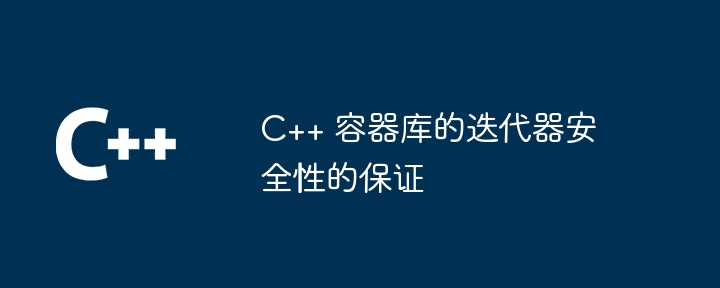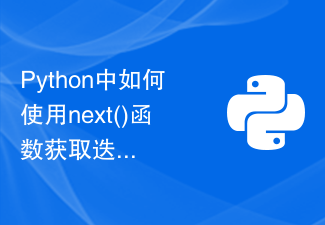 Backend Development
Backend Development PHP7
PHP7 Iterators in PHP7: How to traverse and manipulate large-scale data sets efficiently?
Iterators in PHP7: How to traverse and manipulate large-scale data sets efficiently?
Iterators in PHP7: How to traverse and manipulate large-scale data sets efficiently?
Introduction:
With the rapid development of the Internet and data science, processing large-scale data sets has become a common need for many developers and data analysts. Iterators in PHP7 are a powerful tool that can help us traverse and manipulate large-scale data sets efficiently. This article will introduce iterators in PHP7 and provide some specific code examples to help readers better understand and apply iterators.
1. What is an iterator?
Iterator is a design pattern that provides a way to sequentially access the elements of a collection object without knowing the internal representation of the collection object. In PHP, an iterator is a class that implements the Iterator interface, which provides the ability to access the elements of an object sequentially.
In PHP, we can use iterators to traverse and operate various data structures, such as arrays, files, etc. By using iterators, we can implement a lazy loading and on-demand processing approach that avoids taking up excessive memory and computing resources when processing large data sets.
2. Use iterators to traverse arrays
We can create custom array iterators by implementing the Iterator interface. Here is a simple example that shows how to use an iterator to traverse an array:
class ArrayIterator implements Iterator {
private $arr;
private $index;
public function __construct($arr) {
$this->arr = $arr;
$this->index = 0;
}
public function current() {
return $this->arr[$this->index];
}
public function key() {
return $this->index;
}
public function next() {
$this->index++;
}
public function rewind() {
$this->index = 0;
}
public function valid() {
return isset($this->arr[$this->index]);
}
}
$myArray = [1, 2, 3, 4, 5];
$iterator = new ArrayIterator($myArray);
foreach($iterator as $key => $value) {
echo "Key: $key, Value: $value
";
}By implementing the methods of the Iterator interface, we can define our own iterator class and use it when traversing the array. In this way, we can load the elements of the array on demand, saving memory and computing resources.
3. Use iterators to operate files
When processing large-scale files, using iterators can help us read the file contents line by line without loading the entire file into memory at once. The following is a sample code that uses an iterator to read the contents of a file:
class FileIterator implements Iterator {
private $file;
private $line;
private $current;
public function __construct($file) {
$this->file = fopen($file, 'r');
$this->line = 0;
$this->current = fgets($this->file);
}
public function current() {
return $this->current;
}
public function key() {
return $this->line;
}
public function next() {
$this->current = fgets($this->file);
$this->line++;
}
public function rewind() {
fseek($this->file, 0);
$this->line = 0;
$this->current = fgets($this->file);
}
public function valid() {
return !feof($this->file);
}
}
$file = "data.txt";
$fileIterator = new FileIterator($file);
foreach($fileIterator as $lineNumber => $lineContent) {
echo "Line: $lineNumber, Content: $lineContent
";
}In the above sample code, we define a FileIterator class and implement the methods of the Iterator interface. By using this iterator class, we can read the file contents line by line and only load the contents of the current line when traversing the file, thus saving memory overhead.
Conclusion:
By using iterators in PHP7, we can efficiently traverse and manipulate large-scale data sets. Iterators provide the ability to access object elements in sequence, and can process data structures such as arrays and files on demand, avoiding the waste of memory and computing resources. We hope that the introduction and sample code of this article can help readers better understand and apply iterators, and provide convenience and efficiency when processing large-scale data sets.
The above is the detailed content of Iterators in PHP7: How to traverse and manipulate large-scale data sets efficiently?. For more information, please follow other related articles on the PHP Chinese website!
 C#中如何使用迭代器和递归算法处理数据Oct 08, 2023 pm 07:21 PM
C#中如何使用迭代器和递归算法处理数据Oct 08, 2023 pm 07:21 PMC#中如何使用迭代器和递归算法处理数据,需要具体代码示例在C#中,迭代器和递归算法是两种常用的数据处理方法。迭代器可以帮助我们遍历集合中的元素,而递归算法则能够有效地处理复杂的问题。本文将详细介绍如何使用迭代器和递归算法来处理数据,并提供具体的代码示例。使用迭代器处理数据在C#中,我们可以使用迭代器来遍历集合中的元素,而无需事先知道集合的大小。通过迭代器,我
 PHP程序中的迭代器最佳实践Jun 06, 2023 am 08:05 AM
PHP程序中的迭代器最佳实践Jun 06, 2023 am 08:05 AMPHP程序中的迭代器最佳实践迭代器在PHP编程中是一种非常常用的设计模式。通过实现迭代器接口,我们可以遍历一个集合对象中的元素,而且还可以轻松的实现自己的迭代器对象。在PHP中,迭代器模式可以帮助我们更有效地操作数组、列表等集合对象。在本文中,我们将介绍PHP程序中迭代器的最佳实践,希望能帮助同样在迭代器应用方面工作的PHP开发人员。一、使用标准迭代器接口P
 Golang迭代器实现及使用详解Mar 17, 2024 pm 09:21 PM
Golang迭代器实现及使用详解Mar 17, 2024 pm 09:21 PMGolang是一个快速、高效的静态编译型语言,其简洁的语法和强大的性能让它在软件开发领域备受青睐。在Golang中,迭代器(Iterator)是一种常用的设计模式,用于遍历集合中的元素而无需暴露集合的内部结构。本文将详细介绍如何在Golang中实现和使用迭代器,通过具体的代码示例帮助读者更好地理解。1.迭代器的定义在Golang中,迭代器通常由一个接口和实
 Python中的主要和次要提示Aug 25, 2023 pm 04:05 PM
Python中的主要和次要提示Aug 25, 2023 pm 04:05 PM简介主要和次要提示,要求用户输入命令并与解释器进行通信,使得这种交互模式成为可能。主要提示通常由>>>表示,表示Python已准备好接收输入并执行相应的代码。了解这些提示的作用和功能对于发挥Python的交互式编程能力至关重要。在本文中,我们将讨论Python中的主要和次要提示符,强调它们的重要性以及它们如何增强交互式编程体验。我们将研究它们的功能、格式选择以及在快速代码创建、实验和测试方面的优势。开发人员可以通过理解主要和次要提示符来使用Python的交互模式,从而改善他们的
 C++ 容器库的迭代器安全性的保证Jun 05, 2024 pm 04:07 PM
C++ 容器库的迭代器安全性的保证Jun 05, 2024 pm 04:07 PMC++容器库提供以下机制确保迭代器的安全性:1.容器不变性保证;2.复制迭代器;3.范围for循环;4.Const迭代器;5.异常安全。
 Python中如何使用next()函数获取迭代器的下一个元素Aug 22, 2023 pm 04:40 PM
Python中如何使用next()函数获取迭代器的下一个元素Aug 22, 2023 pm 04:40 PMPython中如何使用next()函数获取迭代器的下一个元素迭代器是Python中很常用的一个概念,它允许我们按照特定的顺序遍历一个数据集合。在迭代过程中,我们经常需要获取迭代器的下一个元素,这时就可以使用next()函数来实现。在Python中,我们可以使用iter()函数将一个可迭代对象转换成一个迭代器。例如,如果我们有一个列表,可以将其转换成迭代器后进
 C++ STL中的迭代器Aug 21, 2023 pm 08:52 PM
C++ STL中的迭代器Aug 21, 2023 pm 08:52 PMC++STL(StandardTemplateLibrary)是C++程序语言的标准库之一,它包含了一系列的标准数据结构和算法。在STL中,迭代器(iterator)是一种非常重要的工具,用于在STL的容器中进行遍历和访问。迭代器是一个类似于指针的对象,它可以指向容器(例如vector、list、set、map等)中的某个元素,并可以在容器中进行移动、
 Java Iterator 和 Iterable 的深入比较:优缺点分析Feb 19, 2024 pm 04:20 PM
Java Iterator 和 Iterable 的深入比较:优缺点分析Feb 19, 2024 pm 04:20 PM概念差异:Iterator:Iterator是一个接口,代表一个从集合中获取值的迭代器。它提供了MoveNext()、Current()和Reset()等方法,允许你遍历集合中的元素,并对当前元素进行操作。Iterable:Iterable也是一个接口,代表一个可迭代的对象。它提供了Iterator()方法,用于返回一个Iterator对象,以便于遍历集合中的元素。使用方式:Iterator:要使用Iterator,需要先获得一个Iterator对象,然后调用MoveNext()方法来移动到下一


Hot AI Tools

Undresser.AI Undress
AI-powered app for creating realistic nude photos

AI Clothes Remover
Online AI tool for removing clothes from photos.

Undress AI Tool
Undress images for free

Clothoff.io
AI clothes remover

AI Hentai Generator
Generate AI Hentai for free.

Hot Article

Hot Tools

SAP NetWeaver Server Adapter for Eclipse
Integrate Eclipse with SAP NetWeaver application server.

EditPlus Chinese cracked version
Small size, syntax highlighting, does not support code prompt function

MantisBT
Mantis is an easy-to-deploy web-based defect tracking tool designed to aid in product defect tracking. It requires PHP, MySQL and a web server. Check out our demo and hosting services.

SublimeText3 Linux new version
SublimeText3 Linux latest version

PhpStorm Mac version
The latest (2018.2.1) professional PHP integrated development tool




